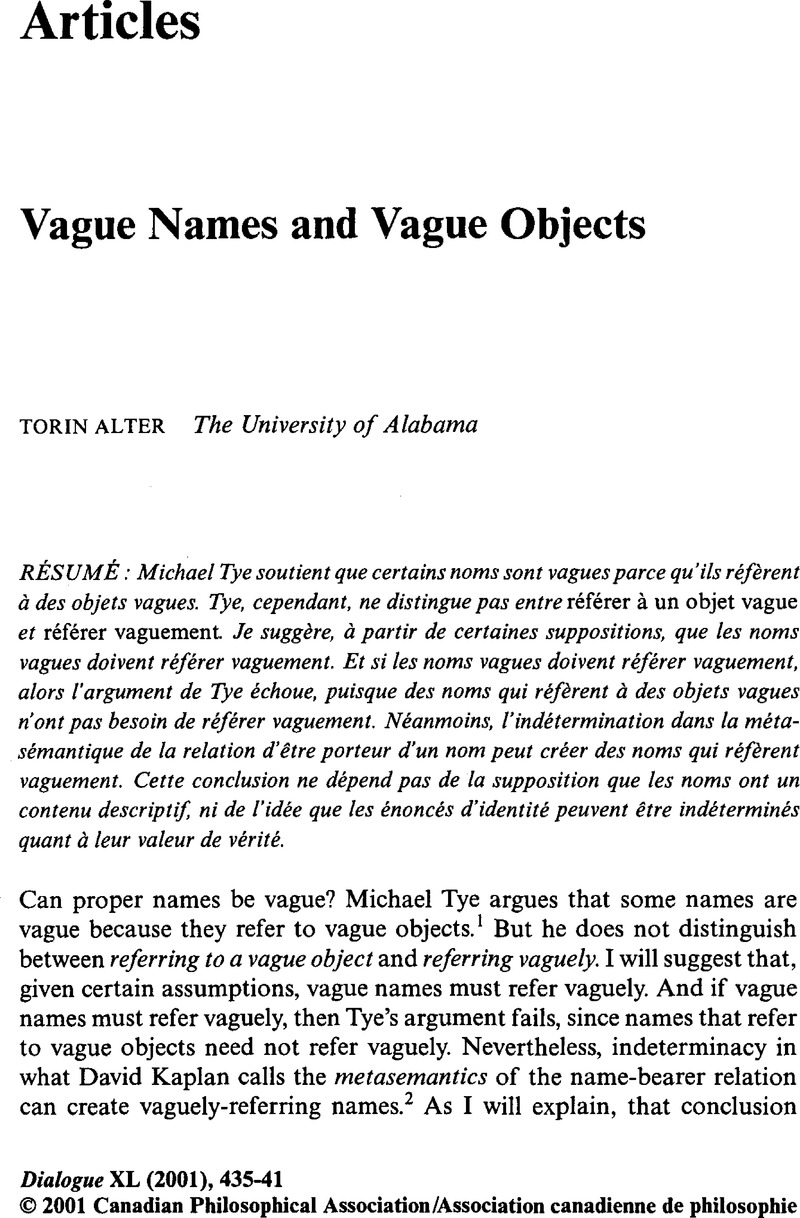No CrossRef data available.
Published online by Cambridge University Press: 13 April 2010

1 Tye, Michael, “Vague Objects,” Mind, 99 (October 1990): 535–57. The argu ment to which I refer appears on pp. 539–40.CrossRefGoogle Scholar
2 Kaplan, David, “Afterthoughts,” in Themes from Kaplan, edited by Almog, J.Perry, J., and Wettstein, H. (New York: Oxford University Press, 1989), pp. 565–614.Google Scholar
3 Tye's official view is that having borderline spatio-temporal parts is necessary but not sufficient for an object o's being vague. Tye also requires that o satisfy the following condition: “there is no determinate fact of the matter about whether there are objects that are neither parts, borderline parts, nor non- parts of o” (“Vague Objects,” p. 536). For our purposes, however, that detail may be ignored.
4 In “Vague Objects,” Tye argues for the doctrine of metaphysical vagueness. For challenges to that doctrine, see Sorenson, Roy, “Sharp Boundaries for Blobs,” Philosophical Studies, 91 (September 1988): 275–95;CrossRefGoogle ScholarHeller, Mark, “Against Metaphysical Vagueness,” in Philosophical Perspectives, Vol. 10Google Scholar, edited by J. Tomberlin (Maiden, MA: Blackwell Publishers, 1996), pp. 177–85; and Pelletier, Francis, “Another Argument against Vague Objects,” Journal of Philosophy, 86 (September 1989): 481–92.CrossRefGoogle Scholar The dispute over metaphysical vagueness is not new. See Russell, Bertrand, “Vagueness,” Australasian Journal of Psychology and Philosophy, 1 (1923): 84–92.CrossRefGoogle Scholar
5 My distinction between precise reference to a vague object and vague refer ence parallels Berkeley's distinction between particular reference to an abstract idea and general reference to any of a range of particular ideas. Berke ley rejects the former in favour of the latter. See Berkeley, George, A Treatise Concerning the Principles of Human Knowledge, edited by Turbayne, C. M. (Indianapolis: Bobbs-Merrill, 1965), pp. 10–11.Google Scholar
6 Sainsbury, R. M., Paradoxes, 2nd ed. (New York: Cambridge University Press, 1995), p. 24.CrossRefGoogle Scholar
7 For the view that names lack descriptive content, see Kripke, Saul, “Naming and Necessity,” in Semantics of Natural Language, edited by Harman, G. and Davidson, D. (Dordrecht, Holland: D. Reidel, 1972), pp. 253–355, 763-69;CrossRefGoogle ScholarDonnellan, Keith, “Proper Names and Identifying Descriptions,” Synthese, 21 (1970): 335–58;CrossRefGoogle Scholar and Marcus, Ruth, “Modalities and Intensional Languages,” Synthese, 13 (1961): 303–22.CrossRefGoogle Scholar
8 Kit Fine remarks that on the supervaluationist view, “Vagueness is ambiguity on a grand and systematic scale” (“Vagueness, Truth, and Logic,” Synthese, 30 [1975]: 265–300, esp. p. 282).CrossRefGoogle Scholar
9 For the notion of fixing the reference, see Kripke, “Naming and Necessity,” Lecture 2. Kripke tends to use “fixing the reference” specifically for fixing the reference by description. I use the phrase in the more general sense of the act of establishing a name-bearer relation, of which reference-fixing description and reference-fixing ostension are two instances.
10 Russell gives a similar argument in “Vagueness,” pp. 86-87. In presenting his argument, however, he tacitly assumes that one cannot use a name to refer to that which does not presently exist. Russell had reasons for that assumption: on his view referring to an object requires being directly acquainted with it, and he had highly restrictive views about the possible objects of direct acquaintance. See his “Knowledge by Acquaintance and Knowledge by Description,” Aristotelean Society Proceedings, 11 (1910–11): 108–28.Google Scholar But his assumption is implausible. In fact, it would seem that “Bertrand Russell” is now used to refer to an object that no longer exists.
11 For the historical-chain theory, see Donnellan, “Proper Names and Identify ing Descriptions,” and Kripke, “Naming and Necessity,” Lecture 2.
12 Kripke, “Naming and Necessity,” pp. 347-48, fn.33.
13 Almog, Joseph, “The Subject-Predicate Class I,” Nous, 25 (December 1991): 591–619, esp. p. 598.CrossRefGoogle Scholar
14 Fine, “Vagueness, Truth, and Logic,” p. 266.
15 Tye also argues that his vague-names thesis is consistent with the thesis that identity sentences cannot be indeterminate in truth value (“Vague Objects,” section 4). The recent discussions of whether identity sentences can be inde terminate in truth value begin with Evans, Gareth, “Can There Be Vague Objects?” Analysis, 38 (October 1978): 208.CrossRefGoogle Scholar
16 I presented this paper at the 1998 Pacific Division Meeting of the American Philosophical Association. I wish to thank my commentator, Loretta Torrago, and those who participated in the discussion. For helpful comments and discussions, I also wish to thank Jay Garfield, Max Hocutt, David Kaplan, Amy Kind, Frank Menetrez, Stuart Rachels, Samuel Rickless, Houston Smit, and an anonymous referee for Dialogue. Finally, I owe a special debt of thanks to William FitzPatrick and Russell Daw.